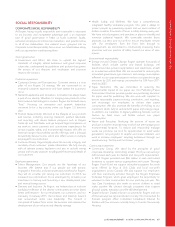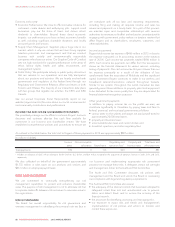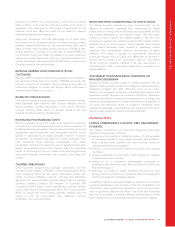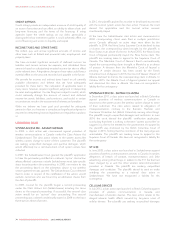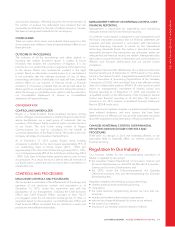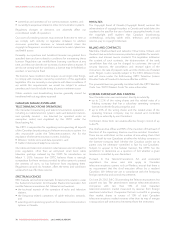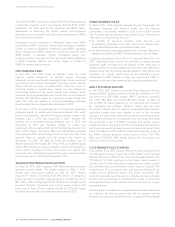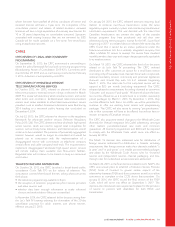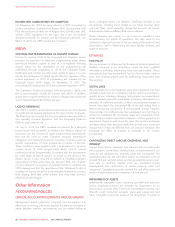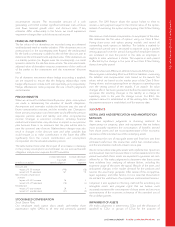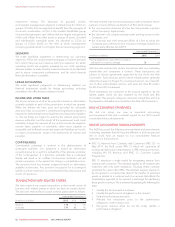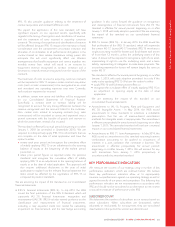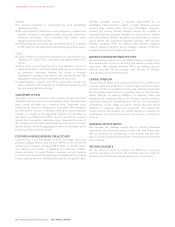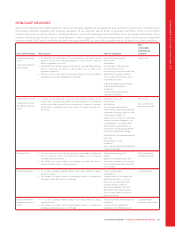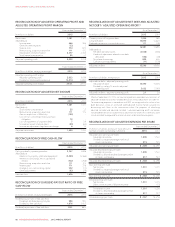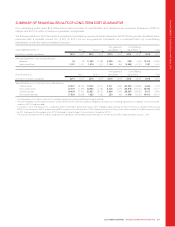Rogers 2015 Annual Report Download - page 79
Download and view the complete annual report
Please find page 79 of the 2015 Rogers annual report below. You can navigate through the pages in the report by either clicking on the pages listed below, or by using the keyword search tool below to find specific information within the annual report.
MANAGEMENT’S DISCUSSION AND ANALYSIS
CRTC REVIEW OF BASIC TELECOMMUNICATIONS SERVICES
On April 9, 2015, the CRTC issued Telecom Notice of Consultation
2015-134. The CRTC will examine which telecommunications
services Canadians require to participate meaningfully in the digital
economy and the CRTC’s role in ensuring the availability of
affordable basic telecommunications services to all Canadians.
Rogers is participating in the proceeding in which a public hearing
will commence on April 11, 2016.
CANADIAN ANTI-SPAM LEGISLATION
Canada’s anti-spam legislation was passed into law on
December 15, 2010 and came into force on July 1, 2014, with the
exception of those sections of the Act related to the unsolicited
installation of computer programs or software, which came into
force on January 15, 2015. We believe we are in compliance with
this legislation.
BILL C-43
On October 23, 2014, Bill C-43 was introduced by the federal
government. Amongst other items, it makes amendments to the
Broadcasting Act and the Telecommunications Act to prohibit
charging subscribers for paper bills. Bill C-43 also provides the
CRTC with the authority to assess Administrative Monetary Penalties
for any contraventions of the Telecommunications Act, regulations,
or CRTC decisions. The Bill was passed into law on December 16,
2014 and these amendments became effective immediately. We
believe we are in compliance with this legislation.
WIRELESS
600 MHZ SPECTRUM LICENCE BAND
On August 14, 2015, ISED Canada released a decision regarding
the reallocation of spectrum licences in the 600 MHz band for
mobile services. Canada will reallocate the same amount of
spectrum licences as the US, following the US incentive auction
scheduled to begin in March 2016. TV channels currently using the
600 MHz band spectrum that will be auctioned for mobile services
will be given a new channel in the new allotment plan and will be
provided with a minimum of 18 months to complete the transition.
Certain Rogers over-the-air TV channels will need to be
transitioned. No decision has been made regarding transition
funding of affected TV channels or whether ISED Canada will use
an incentive auction format. Additional consultations are expected
before the Canadian auction of this spectrum, which is expected to
occurinthenexttwotothreeyears.
LEGISLATION REGARDING WHOLESALE DOMESTIC
WIRELESS ROAMING RATES
On June 19, 2014, the federal government enacted legislation to
cap wholesale domestic wireless roaming rates carriers can charge
to one another at amounts no higher than the average rates carriers
charge their own retail customers. The legislation also provided the
CRTC with the power to set domestic roaming rates between
carriers, regardless of the formula. The CRTC conducted a review
into wireless roaming rates and the state of wireless wholesale
competition with a public hearing, which concluded in early
October 2014.
On May 5, 2015, the CRTC released its decision on the regulatory
framework for wholesale mobile wireless services (Telecom
Regulatory Policy 2015-177). The CRTC determined it is necessary
to regulate the rates that Rogers Communications and two of its
competitors (Bell Mobility and Telus Communications) charge
other Canadian wireless carriers for domestic GSM-based
wholesale roaming. The CRTC directed Rogers, Bell, and Telus to
each file proposed cost-based tariffs for wholesale roaming on
November 4, 2015. Pending its final determination on the
proposed tariffs, the CRTC approved, on an interim basis, a
maximum rate for each of GSM-based voice, text, and data
wholesale roaming provided by Bell, Rogers, and Telus across their
respective networks to other Canadian wireless carriers. This rate is
equal to the highest rate charged by each of Rogers, Bell, and Telus
to any other Canadian wireless carrier for each of GSM-based
voice, text, and data wholesale roaming as of the date of the
decision. These rates were replaced when the CRTC gave interim
approval to the proposed cost-based tariffs filed by the carriers on
December 3, 2015 and made these interim rates effective
November 23, 2015.
In Telecom Regulatory Policy 2015-177 the CRTC recommended
that the Canadian government repeal section 27.1 of the
Telecommunications Act, which came into effect in June 2014 to
cap domestic wholesale mobile wireless roaming rates at average
retail rates, to allow the return to market forces for the provision of
all other wholesale roaming as soon as possible. On July 1, 2015,
section 27.1 was repealed by the government.
The CRTC further determined that it is not appropriate to mandate
wholesale Mobile Virtual Network Operator (MVNO) access.
Finally, the CRTC determined that the regulatory measures
establishedinthedecisionwouldremaininplaceforaminimumof
five years, during which time the CRTC will monitor competitive
conditions in the mobile wireless market.
TRANSFERS, DIVISIONS, AND SUBORDINATE LICENSING
OF SPECTRUM LICENCES
In June 2013, ISED Canada released Framework Relating to
Transfers, Divisions and Subordinate Licensing of Spectrum
Licences for Commercial Mobile Spectrum. The Framework lays
out the criteria ISED Canada will consider and the processes it will
use when it reviews spectrum licence transfers, including
prospective transfers that could arise from purchase or sale options
and other agreements. Key items to note are that:
• ISED Canada will review all spectrum transfer requests, and will
not allow any that result in “undue spectrum concentration” and
reduced competition. Decisions will be made on a case-by-case
basis and will be issued publicly to increase transparency; and
• licensees must ask for a review within 15 days of entering into
any agreement that could lead to a prospective transfer. ISED
Canada will review the agreement as though the licence transfer
that could arise from it has been made. This timing did not apply
to agreements such as Rogers’ AWS agreements with Shaw and
Quebecor made before the Framework was released.
On June 24, 2015, Rogers received ISED Canada approval for a
number of spectrum licence transfers and subordinate licences
related to our acquisition of Shaw’s AWS-1 spectrum licences and
our acquisition of Mobilicity.
2015 ANNUAL REPORT ROGERS COMMUNICATIONS INC. 77


